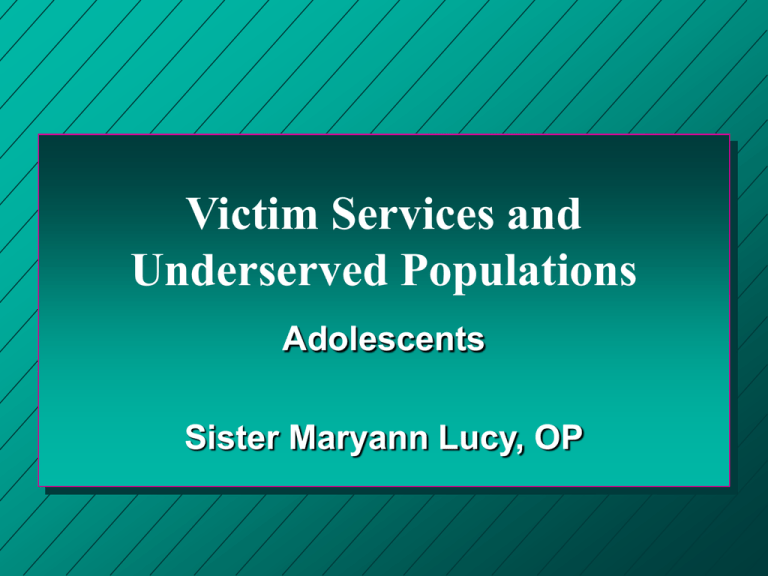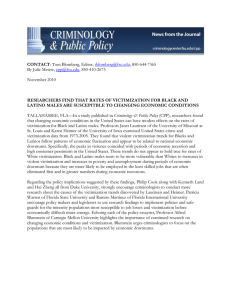
Victim Services and
Underserved Populations
Adolescents
Sister Maryann Lucy, OP
Goals
• Developmental profile of adolescents
• High risk factors for adolescents
• Addressing victimization
• Males
• Females
• Early identification of chronic offenders
Developmental Profile
•
Adolescence:
a) A distinct period of growth between childhood
and adulthood
b) Ages 10 – 15
•
Physical Development:
a)
b)
c)
d)
Accelerated and uneven growth spurts
Changes in skeletal/muscular system
Fluctuation in basal metabolism
Hormonal changes!
Developmental Profile (Cont.)
•
Brain Development:
a) Prefrontal cortex is not fully developed
b) Affects: Planning, reasoning, anticipating
consequences, sustaining attention and
making decisions
•
Intellectual Development
a) Understanding
b) Reasoning
c) Period of great curiosity
Developmental Profile (Cont.)
Teens are in progress from concrete
logical operations to:
a) Developing and testing
hypotheses
b) Analyzing and synthesizing data
c) Grappling with complex concepts
d) Thinking reflectively
MORAL/ETHICAL
DEVELOPMENT
A movement from blanket acceptance of
adult moral judgment to a development
of personal values.
Teens are at risk for making unsound
moral and ethical choices.
EMOTIONAL/PSYCHOLOGICAL
DEVELOPMENT
A. Quest for independence and identity
formation
B. Heightened feelings of vulnerability
C. Emotionally charged situations produce
childish reactions
D. Naïve opinions/one-sided arguments
Social maturity often lags behind physical and
intellectual development.
TASKS IN PROCESS
A.
B.
C.
D.
Achieving mature relationships with others
Achieving masculine/feminine social role
Accepting one’s physique
Achieving emotional independence from
parents/adults
E. Preparing for marriage and family/economic
career
F. Acquiring values and ethical system
G. Achieving socially responsive behaviors
HIGH RISK FACTORS
A.
B.
C.
D.
E.
F.
G.
H.
Physical/sexual abuse
Exposure to violence in home/community
Socio-economic stressors
Gang affiliations
Weak social ties
Intense anger/low frustration levels
Illicit drugs
Sexual activity
High Risk Factors (Cont.)
When interviewing victimized youth utilize
a “global assessment” perspective.
Remember to take into account
developmental stages, past and present
stressors, physical health and relational
style.
High Risk Factors (Cont.)
IF IN DOUBT, TEST IT OUT!
• MMPI-A
• Millon Adolescent Clinical Inventory
(MACI:1993)
• Adolescent Psychopathology Scale (APS)
(Reynolds, 1995)
• Psychopathy Checklist – Revised (Hare,
1991)
ADDRESSING VICTIMIZATION
MALES
“Sexual abuse of boys appears to be common, under
reported, under recognized and under treated”
(Holmes & Slap, 1998)
“A boy is abused for every 2 to 4 girls abused. Those
who work with RUNAWAYS, MALE CHILD
PROSTITUTES OR INPATIENT MALES IN
PSYCHIATRIC UNITS, are very likely to encounter
abused boys” (Wathins, 1992)
Addressing victimization (Cont.)
ASSESS EXTERNALIZED BEHAVIORS:
a)
b)
c)
d)
e)
Poor school performance
Delinquent activities
Sexual risk taking
More extreme use of alcohol
Frequent and extreme use of
marijuana
Addressing Victimization (Cont.)
50% of abused teens are diagnosed with PTSD.
Of this 50% there is a higher rate of diagnosis
for boys.
• High risk behavior includes problems in
school, eating and sleeping disturbances,
flashbacks and fear of places and people.
The aftermath of abuse of boys might be worse
or more complex than for girls.
Addressing Victimization (Cont.)
•
•
•
•
•
•
•
•
THEMES OF ABUSED MALES
Anger/betrayal
Homosexuality/Masculine Issues
Hopelessness
Isolation/Alienation
Legitimacy
Loss
Self-blame and guilt
Shame and humiliation
Addressing Victimization (Cont.)
WATCH FOR
• More problems with aggressive and
social interactions
• Oversensitivity to negative statements
by peers
• Increased sexual acting out behaviors
Addressing Victimization (Cont.)
FEMALES
Females report sexual abuse more often
than males, but ARE MORE OFTEN
BLAMED FOR THE SEXUAL
ADVANCES OF A MALE OFFENDER
EVEN WHEN A FEMALE VICTIM IS A
YOUNG CHILD.
Addressing Victimization (Cont.)
•
•
•
•
•
Seduction
“Liking it / Wanting it”
Sexual response to the abuse
Dress: “Asking for it”
Female body is developed: “Acting older
than she is”
Addressing Victimization (Cont.)
•
•
•
•
•
WATCH FOR INTERNALIZED
BEHAVIORS
Depression / Isolation
Suicidal ideation and behavior
Eating disturbances
Self-mutilation
More frequent use of alcohol
EARLY IDENTIFICATION
Adult peak criminal activity occurs between 1826 years of age. (California Youth Authority)
Precipitated by serious and consistent conduct
problems starting at early childhood
FAMILY ADVERSITY
EARLY IDENTIFICATION
CALLOUS AND UNEMOTIONAL
PROFILE
• Overt indicators: Bullying, fighting,
leading to…
• Covert indicators: Lying / Stealing,
property damage, authority conflicts
EARLY IDENTIFICATION
•
•
•
•
•
HIGH RISK FACTORS
Academic Failure
Suspensions and truancy
Lack of family stability
Mental health and substance abuse problems
Pre-delinquent behaviors such as: running
away, gang affiliation, acting disruptive and
stealing
EARLY IDENTIFICATION
DUAL DIAGNOSIS IN CHILDHOOD
• HIPERACTIVITY DISORDER
• CONDUCT DISORDER
TEST OUT FOR VALIDATION
EARLY IDENTIFICATION
• What can we do together to prevent the
potential for adolescent offenders becoming
chronic offenders?
• Family adversity is prime factor in predicting
offending behavior in adolescence. What do
we do about this?
• Approximately 85% of offending teens stop
offending as they mature into adulthood.
How we can we help the others?
Essentials of Forensic Psychological
Assessment (Ackerman, Marc J., 1999)
Forensic Evaluation of Juveniles
(Thomas Grisso, 1998)
THANK YOU!




